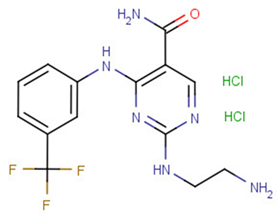
Syk Inhibitor II (hydrochloride)
CAS No. 227449-73-2
Syk Inhibitor II (hydrochloride)( —— )
Catalog No. M17447 CAS No. 227449-73-2
Spleen tyrosine kinase (Syk) is a non-receptor tyrosine kinase that, upon phosphorylation, binds to immunoreceptor tyrosine-based activation motifs of FcRγ chains and mediates downstream signaling related to platelet function and inflammation.
Purity : >98% (HPLC)
 COA
COA
 Datasheet
Datasheet
 HNMR
HNMR
 HPLC
HPLC
 MSDS
MSDS
 Handing Instructions
Handing Instructions
| Size | Price / USD | Stock | Quantity |
| 2MG | 201 | In Stock |


|
| 5MG | 431 | In Stock |


|
| 10MG | 614 | In Stock |


|
| 25MG | 896 | In Stock |


|
| 50MG | 1197 | In Stock |


|
| 100MG | 1611 | In Stock |


|
| 200MG | Get Quote | In Stock |


|
| 500MG | Get Quote | In Stock |


|
| 1G | Get Quote | In Stock |


|
Biological Information
-
Product NameSyk Inhibitor II (hydrochloride)
-
NoteResearch use only, not for human use.
-
Brief DescriptionSpleen tyrosine kinase (Syk) is a non-receptor tyrosine kinase that, upon phosphorylation, binds to immunoreceptor tyrosine-based activation motifs of FcRγ chains and mediates downstream signaling related to platelet function and inflammation.
-
DescriptionSpleen tyrosine kinase (Syk) is a non-receptor tyrosine kinase that, upon phosphorylation, binds to immunoreceptor tyrosine-based activation motifs of FcRγ chains and mediates downstream signaling related to platelet function and inflammation. Syk inhibitor II is a cell-permeable, pyrimidine-carboxamide compound that selectively and reversibly blocks Syk (IC50 = 41 nM) in an ATP-competitive manner. It is much less potent against PKCε, PKCβII, ZAP-70, Btk, and Itk (IC50s = 5.1, 11, 11.2, 15.5, and 22.6 μM, respectively).
-
In Vitro——
-
In Vivo——
-
Synonyms——
-
PathwayOthers
-
TargetOther Targets
-
RecptorSyk| PKCε| PKCβII| ZAP-70| Btk| Itk
-
Research AreaInfection
-
Indication——
Chemical Information
-
CAS Number227449-73-2
-
Formula Weight413.22
-
Molecular FormulaC14H17Cl2F3N6O
-
Purity>98% (HPLC)
-
Solubility——
-
SMILESNCCNC1=NC(NC2=CC(C(F)(F)F)=CC=C2)=C(C(N)=O)C=N1.Cl.Cl
-
Chemical Name——
Shipping & Storage Information
-
Storage(-20℃)
-
ShippingWith Ice Pack
-
Stability≥ 2 years
Reference
1. Hisamichi H, etal. Bioorganic & medicinal chemistry, 2005, 13(16): 4936-4951.
molnova catalog



related products
-
Angiotensin I/II 1-5
Angiotensin I/II (1-5) is a peptide (ASP-ARG-VAL-TYR-ILE) that contains the amino acids 1-5 and is converted from Angiotensin I/II.
-
Loxiglumide
Loxiglumide is a cholecystokinin (CCK-1) receptor antagonist.
-
FM4-64
FM4-64 (SynaptoRedTM C2) is a styryl dye that stains stably but does not fluoresce in aqueous solution.FM4-64 does not passively diffuse into the plasma membrane bilayer and must be actively transported across the membrane.



 Cart
Cart
 sales@molnova.com
sales@molnova.com


